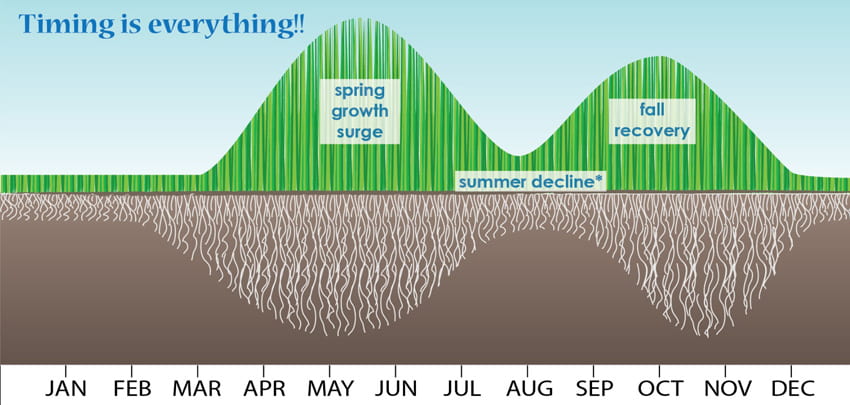When establishing a new stand of turf on sandy type soils apply 0.4 pound of a soluble nitrogen per 1,000 sq. ft. or up to 1 pound of total nitrogen with fertilizers with at least 60% slow release nitrogen. If in 4-6 weeks the turf is not dense and it is before November 1 make another application at the same rate. If it is after November 1 wait until mid-May to make this application.
On non-sandy soils apply 0.7 pound of a soluble nitrogen per 1,000 sq. ft. or up to 1 pound of total nitrogen with fertilizers with at least 30% slow release nitrogen. If in 4-6 weeks the turf is not dense and it is before November 1 make another application at the same rate or less. If it is after November 1 wait until mid-May to make this application.
Fertilizing established turf
Understanding how cool season grasses grow and develop will help in understanding the strategy behind specific timing of established turf.
Focus your fertility program on building a healthy root system. Sixty percent (60%) of your fertilizer applications should be made in the fall when the roots can benefit from it the most. An extensive root system is better able to survive stress next summer.

When a fall application was not made and spring sports are planned a light nitrogen application can be done in early spring after April 1st. Heavy spring fertilizer applications, however, lead to excessive shoot and leaf growth and poor root growth. This leaves the turf less likely to handle the harsh summer conditions.
Unless you are irrigating the turf there may be little or no need to fertilize in the summer if it is dry. If an early summer application is desired to repair damaged fields from spring use, select a slow release type like a natural organic source which release nitrogen slower than conventional water soluble sources.
A late summer fertilizer application (mid-August) is important because it promotes recovery from the summer’s drought and heat related stress. Select a fertilizer with a 50:50 water soluble N: slow release form and apply at the ¾ -1 lb nitrogen rate per 1000 sq. ft.
Early fall fertilization (September) increases turf density by encouraging the production of new tillers, rhizomes and stolons and more shoot growth from existing turf. The production of carbohydrates at this time will help turf survive the stresses of winter and encourage spring growth. October fertilization will maximize turf growth and recovery from fall sports.
Fertilizing turf when the soil is not frozen and when foliar growth slows down (when air temperatures are <50° for 10 days) contributes to significant root, rhizome and stolon growth.
Also, turf color is extended into the late fall and early winter and early spring green up is promoted. Be careful, however, with late season nitrogen applications on sites with ground water issues, like Long Island. Follow state and local laws on the last date to apply fertilizer which may be November 1st or November 15th in your area. If you choose this option select a nitrogen source that is not temperature dependent, like IBDU and SCU and apply at the ¾ lb. rate or urea at the ½ lb. per 1,000 sq. ft. nitrogen rate.
Sample fertilizer program for football fields
Situation: no spring sports on this field
Minimal management field rates are bolded
High management fields rates are in red
| Timing | Nitrogen rate per 1,000 sq. ft. |
Nitrogen source |
Comments and strategy |
|---|---|---|---|
| Before April 1st | Do not apply fertilizer. | ||
| Early spring | If late fall fertilization applied previous year, early fertilization may not be needed | ||
| Mid-late May | 1# 1# |
50% water soluble or use a 100% organic source | Warm soil temperatures release nutrients. Organic sources build up soil nitrogen and feed microorganisms. |
| July | No need to fertilize especially if fields are not irrigated. | ||
| Mid-August | 1# 1# |
50% water soluble | Apply just before the season begins. |
| Mid-September | 1# | 50% water soluble | |
| Mid-October | ½ # | 100% water soluble | |
| November | New York State or local laws may prohibit application of fertilizer at this time. |


